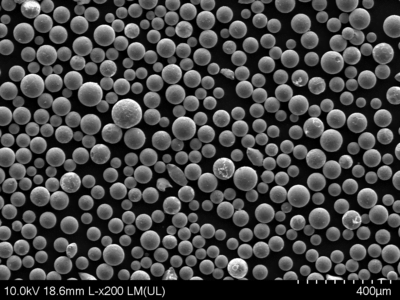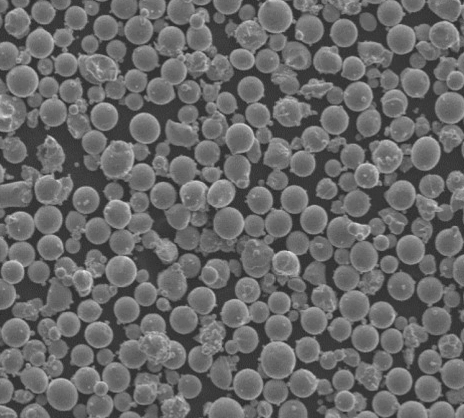Benvenuti nell'affascinante mondo di metallic powders! If you’ve ever been curious about the tiny particles that make up some of the most innovative materials in modern manufacturing, you’re in the right place. This guide will delve deep into metallic powders, exploring their types, compositions, properties, applications, and much more. Whether you’re a seasoned engineer, a curious student, or just someone with a keen interest in materials science, there’s something here for you.
Overview of Metallic Powders
Metallic powders are fine particles of metals used in various industrial applications. These powders are essential in manufacturing, offering unique properties that make them suitable for creating complex shapes, achieving specific mechanical properties, and producing materials with enhanced performance characteristics. From additive manufacturing (3D printing) to powder metallurgy and beyond, metallic powders play a crucial role in modern technology.
Dettagli chiave
- Definizione: Finely divided particles of metal.
- Metodi di produzione: Atomizzazione, riduzione, elettrolisi, leghe meccaniche.
- APPLICAZIONI: Additive manufacturing, powder metallurgy, thermal spraying, MIM (Metal Injection Molding).
- Vantaggi: High precision, material efficiency, complex shapes, customizable properties.
- Svantaggi: Cost, handling hazards, powder consistency.

Tipi di Polveri metalliche
1. Polvere di alluminio
Aluminum powder is lightweight, corrosion-resistant, and highly conductive. It’s widely used in automotive parts, aerospace components, and fireworks.
Composizione: Pure aluminum or aluminum alloys.
Proprietà:
- Poco ingombrante
- Alta conducibilità termica ed elettrica
- Buona resistenza alla corrosione
APPLICAZIONI:
- Componenti automobilistici
- Componenti per l'industria aerospaziale
- manifattura additiva
2. Copper Powder
Copper powder is known for its excellent electrical and thermal conductivity. It’s a key material in electronics, batteries, and conductive inks.
Composizione: Pure copper or copper alloys.
Proprietà:
- Eccellente conducibilità elettrica
- Elevata conducibilità termica
- Antimicrobial properties
APPLICAZIONI:
- Elettronica
- Batteries
- Conductive inks
3. Polvere di ferro
Iron powder is versatile, used in various applications from automotive to industrial manufacturing. It’s known for its magnetic properties and strength.
Composizione: Pure iron or iron alloys.
Proprietà:
- High magnetic permeability
- Strong and durable
- Economicamente vantaggioso
APPLICAZIONI:
- Powder metallurgy
- Magnetic materials
- Componenti automobilistici
4. Titanium Powder
Titanium powder is highly valued for its strength, lightweight nature, and corrosion resistance, making it ideal for aerospace and medical implants.
Composizione: Pure titanium or titanium alloys.
Proprietà:
- Elevato rapporto resistenza-peso
- Eccellente resistenza alla corrosione
- Biocompatibile
APPLICAZIONI:
- Componenti per l'industria aerospaziale
- Impianti medici
- manifattura additiva
5. Polvere di nichel
Nickel powder is used in batteries, catalysts, and electronics due to its excellent corrosion resistance and high-temperature stability.
Composizione: Pure nickel or nickel alloys.
Proprietà:
- Eccellente resistenza alla corrosione
- Stabilità alle alte temperature
- Good mechanical properties
APPLICAZIONI:
- Batteries
- Catalizzatori
- Elettronica
6. Stainless Steel Powder
Stainless steel powder combines the benefits of iron and chromium, offering corrosion resistance and strength. It’s used in a wide range of applications.
Composizione: Iron-chromium alloys.
Proprietà:
- Resistenza alla corrosione
- elevata resistenza
- Resistenza all'usura
APPLICAZIONI:
- Dispositivi medici
- Food processing equipment
- manifattura additiva
7. Cobalt Powder
Cobalt powder is crucial in high-performance alloys and battery materials, known for its magnetic properties and high melting point.
Composizione: Pure cobalt or cobalt alloys.
Proprietà:
- Punto di fusione elevato
- Proprietà magnetiche
- Resistenza all'usura
APPLICAZIONI:
- Leghe ad alte prestazioni
- Batteries
- Cutting tools
8. Zinc Powder
Zinc powder is widely used in protective coatings and batteries due to its anti-corrosion properties and electrochemical behavior.
Composizione: Pure zinc or zinc alloys.
Proprietà:
- Anti-corrosion properties
- Good electrochemical behavior
- High reactivity
APPLICAZIONI:
- Protective coatings
- Batteries
- Chemical reagents
9. Tungsten Powder
Tungsten powder is used in high-temperature applications and radiation shielding, valued for its high density and melting point.
Composizione: Pure tungsten or tungsten alloys.
Proprietà:
- Alta densità
- Punto di fusione elevato
- Eccellente resistenza all'usura
APPLICAZIONI:
- Applicazioni ad alta temperatura
- Radiation shielding
- Cutting tools
10. Magnesium Powder
Magnesium powder is lightweight and has high specific strength, used in aerospace, automotive, and electronics industries.
Composizione: Pure magnesium or magnesium alloys.
Proprietà:
- Poco ingombrante
- High specific strength
- Buona lavorabilità
APPLICAZIONI:
- Componenti per l'industria aerospaziale
- Componenti automobilistici
- Elettronica






Proprietà e caratteristiche di Polveri metalliche
| Tipo | Composizione | Proprietà | APPLICAZIONI |
|---|---|---|---|
| Polvere di alluminio | Pure aluminum or alloys | Leggero, conduttivo, resistente alla corrosione | Automotive, aerospace, fireworks |
| Polvere di rame | Pure copper or alloys | Conductive, antimicrobial | Electronics, batteries, conductive inks |
| Polvere di ferro | Pure iron or alloys | Magnetic, strong, cost-effective | Powder metallurgy, automotive |
| Polvere di titanio | Pure titanium or alloys | Strong, lightweight, biocompatible | Aerospaziale, impianti medici |
| Polvere di nichel | Pure nickel or alloys | Corrosion-resistant, stable at high temps | Batteries, catalysts, electronics |
| Polvere di acciaio inossidabile | Iron-chromium alloys | Corrosion-resistant, strong, wear-resistant | Dispositivi medici, lavorazione degli alimenti |
| Cobalto in polvere | Pure cobalt or alloys | High melting point, magnetic, wear-resistant | High-performance alloys, batteries |
| Zinco in polvere | Pure zinc or alloys | Anti-corrosion, electrochemical | Protective coatings, batteries |
| Polvere di tungsteno | Pure tungsten or alloys | High density, high melting point, wear-resistant | High-temp applications, radiation shielding |
| Magnesio in polvere | Pure magnesium or alloys | Lightweight, high specific strength, machinable | Aerospace, automotive, electronics |
Applications of Metallic Powders
manifattura additiva
Additive manufacturing, or 3D printing, is revolutionizing how we produce complex parts. Metallic powders are essential in this process, allowing for high precision and material efficiency. Metals like titanium and aluminum are particularly popular in aerospace and medical industries due to their lightweight and strong properties.
Metallurgia delle polveri
Powder metallurgy is a manufacturing process where metallic powders are compacted and sintered to create solid parts. This method is cost-effective and allows for producing components with intricate shapes and specific properties, commonly used in automotive and industrial applications.
Termo-spruzzatura
Thermal spraying involves spraying metallic powders onto surfaces to create coatings that enhance wear resistance, corrosion resistance, or thermal insulation. This technique is widely used in aerospace, automotive, and industrial machinery.
Stampaggio a iniezione di metallo (MIM)
MIM combines the versatility of plastic injection molding with the strength and integrity of metal. Metallic powders are mixed with a binder to create a feedstock, which is then injected into a mold. This process is ideal for producing small, complex parts with high precision.
Batteries
Metallic powders like nickel and cobalt are crucial in battery production, especially in rechargeable batteries like lithium-ion. These metals provide the necessary electrochemical properties to store and release energy efficiently.
Elettronica
Copper and silver powders are commonly used in electronics due to their excellent electrical conductivity. They are used in conductive inks, printed circuits, and various electronic components.

Comparing Metallic Powders: Advantages and Disadvantages
| Tipo | Vantaggi | Svantaggi |
|---|---|---|
| Polvere di alluminio | Leggero, resistente alla corrosione, conduttivo | Can be expensive, handling hazards |
| Polvere di rame | Excellent conductivity, antimicrobial | Oxidizes easily, relatively expensive |
| Polvere di ferro | Cost-effective, strong, magnetic | Prone to rust, requires protective coating |
| Polvere di titanio | Elevato rapporto resistenza/peso, biocompatibile | Costoso, reattivo in polvere |
| Polvere di nichel | Corrosion-resistant, high-temp stability | Expensive, health hazards if inhaled |
| Polvere di acciaio inossidabile | Resistente alla corrosione, forte | Expensive, harder to machine |
| Cobalto in polvere | High melting point, magnetic, wear-resistant | Expensive, toxic if not handled properly |
| Zinco in polvere | Anti-corrosion, good electrochemical behavior | Can react with moisture, handling hazards |
| Polvere di tungsteno | High density, high melting point, wear-resistant | Very dense, hard to work with |
| Magnesio in polvere | Lightweight, high specific strength, machinable | Highly reactive, flammable in powder form |
Specifiche, dimensioni, gradi, standard
Specifiche e dimensioni
| Tipo | Intervallo delle dimensioni | Gradi comuni | Standard |
|---|---|---|---|
| Polvere di alluminio | 1-100 µm | 1050, 1100, 2024 | ASTM B928, ISO 6361 |
| Polvere di rame | 0.5-45 µm | C11000, C10100 | ASTM B170,ISO 4503 |
| Polvere di ferro | 1-200 µm | A1000, ASC100.29 | ASTM B783, ISO 4497 |
| Polvere di titanio | 10-500 µm | CP1, Ti6Al4V | ASTM B348, ISO 5832-2 |
| Polvere di nichel | 2-150 µm | Ni201, Ni205 | ASTM B330, ISO 6284 |
| Polvere di acciaio inossidabile | 5-150 µm | 304L, 316L | ASTM A276, ISO 4954 |
| Cobalto in polvere | 1-100 µm | CoCrMo, CoCrFeNi | ASTM F75, ISO 5832-12 |
| Zinco in polvere | 0.5-50 µm | Zn22, Zn94 | ASTM B860, ISO 3549 |
| Polvere di tungsteno | 0.1-200 µm | W1, W2 | ASTM B777, ISO 6848 |
| Magnesio in polvere | 1-500 µm | AZ31B, WE43 | ASTM B107, ISO 16220 |
Fornitori e dettagli sui prezzi
| Fornitore | Polveri metalliche Available | Fascia di prezzo (per kg) | Sito web |
|---|---|---|---|
| Materiali avanzati | Aluminum, Titanium, Copper, Nickel | $20 – $200 | www.advancedmaterials.com |
| Polveri metalliche globali | Iron, Stainless Steel, Zinc, Magnesium | $10 – $150 | www.globalmetalpowders.com |
| Powder Alloy Corporation | Cobalto, nichel, tungsteno | $50 – $300 | www.powderalloycorp.com |
| Prodotti metallici speciali AMETEK | Aluminum, Iron, Stainless Steel | $30 – $250 | www.ametekmetals.com |
| Produzione di polveri metalliche | Copper, Zinc, Iron, Nickel | $15 – $180 | www.makinmetals.com |

FAQ
| Domanda | Risposta |
|---|---|
| What are metallic powders? | Finely divided particles of metals used in various industrial applications. |
| How are metallic powders produced? | Common methods include atomization, reduction, electrolysis, and mechanical alloying. |
| What are the main uses of metallic powders? | Additive manufacturing, powder metallurgy, thermal spraying, metal injection molding, and more. |
| What are the benefits of using metallic powders? | They allow for high precision, material efficiency, and the creation of complex shapes. |
| Are there any disadvantages to using metallic powders? | They can be costly, pose handling hazards, and require consistent quality control. |
| How should metallic powders be stored? | In a dry, cool place, away from any sources of ignition, and in tightly sealed containers. |
| Can metallic powders be recycled? | Yes, many metallic powders can be recycled, depending on the metal and the application. |
| What safety precautions are necessary when handling metallic powders? | Use protective gear, ensure proper ventilation, and follow all safety guidelines to prevent inhalation and fire hazards. |
| What industries benefit most from metallic powders? | Aerospace, automotive, electronics, medical, and industrial manufacturing. |
| How does the particle size of metallic powders affect their use? | Smaller particles offer higher surface area and reactivity, while larger particles may provide better flow characteristics. |
Conclusione
Metallic powders are a critical component in modern manufacturing, offering unique properties and capabilities that traditional bulk metals can’t match. From their use in innovative additive manufacturing processes to their essential role in everyday products, metallic powders continue to push the boundaries of what’s possible in material science. Understanding their types, properties, and applications can open up a world of possibilities, whether you’re looking to improve product performance, explore new manufacturing techniques, or simply expand your knowledge.
Informazioni su 3DP mETAL
Categoria di prodotto
CONTATTACI
Hai domande? Scrivici un messaggio ora! Dopo aver ricevuto il tuo messaggio, informeremo sull'elaborazione della tua richiesta a tutto il team.
